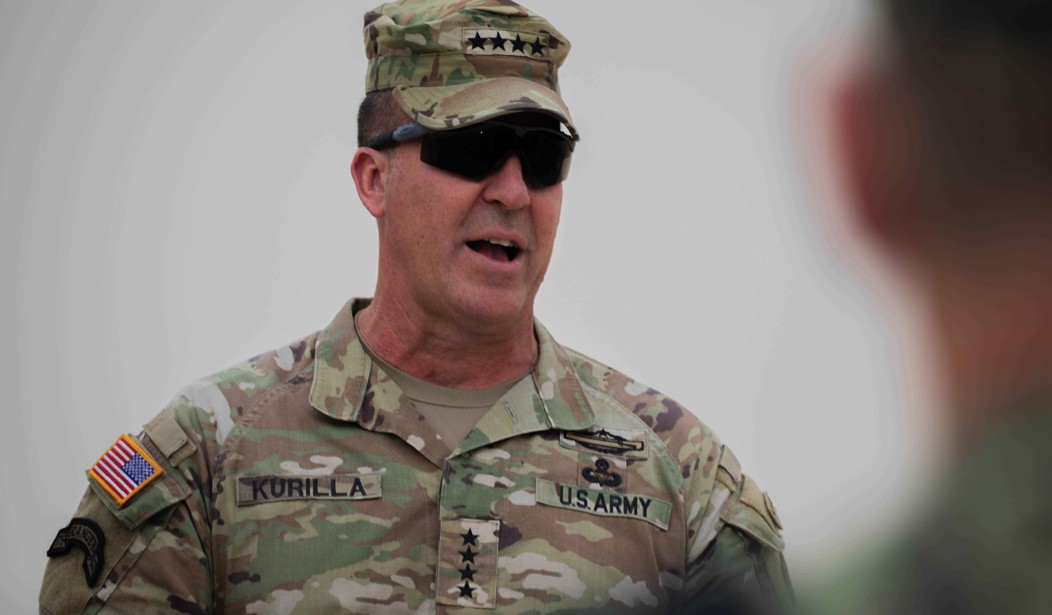The commanding general of U.S. Central Command landed in Tel Aviv, Israel, Monday as the combatant command ramps up its support for the Jewish State still reeling from the vicious surprise attacks Hamas launched Oct. 7 against Israelis.
“I’m here to ensure that Israel has what it needs to defend itself, and I am particularly focused on avoiding other parties expanding the conflict," said Gen. Michael “Erik” Kurilla.
According to the CENTCOM release, the general came to Israel to conduct high-level meetings with Israel's military leadership, such as Chief of Defense Lt. Gen. Herzi Halevi.
Kurilla, whose call sign is "Lucky 6," is looking to gain a clear understanding of Israel's military needs, communicate the U.S. efforts to contain the conflict with Hamas—and to reiterate the Pentagon's ironclad support for Israel, the release said.
Shortly after the attacks began, CENTCOM issued a statement:
U.S. CENTCOM is closely tracking the situation surrounding the appalling terrorist attack by Hamas against the people of Israel. We stand with Israel and extend our condolences for the lives lost in these attacks. U.S. CENTCOM remains in communication with our counterparts.
My RedState colleague Jeff Charles described the buildup in his piece "Pentagon Is Doubling U.S. Military Presence in Middle East to Deter Further Attacks on American Interests."
Kurilla was in Egypt Sept. 14, where he met with Egypt’s military leadership at a live fire exercise that was part of the multinational Bright Star 2023 exercise hosted by CENTCOM in order to improve Egypt’s interoperability in irregular warfare against hybrid threat scenarios in the air, land, and sea domains.
Ike brings expanded capability as carrier joins Ford in the Eastern Mediterranean
USS Dwight D. Eisenhower got underway from its Norfolk, Virginia, homeport Oct. 14, which was its already scheduled deployment.
Defense Secretary Lloyd Austin announced that same day he was sending Ike to Israeli battlespace:
I have directed the USS Dwight D. Eisenhower Carrier Strike Group to begin moving to the Eastern Mediterranean. As part of our effort to deter hostile actions against Israel or any efforts toward widening this war following Hamas's attack on Israel.
Eisenhower not only brings more lethality to the USS Gerald R. Ford Strike Group already there, but also the carrier has new medical capabilities, as it deploys with an En-Route Care System for the first time.
The ERCS consists of a critical care nurse and a search and rescue medical technician trained to provide uninterrupted medical attention for one or two seriously injured patients as they are evacuated to a more sophisticated healthcare facility.
Ford and its carrier strike group came on station off the coast of Israel Oct. 10. This was a relatively simple diversion for Ford, as the strike group was already steaming in the Mediterranean after completing a training exercise with the Italian navy Oct. 4 in the Ionian Sea.
Kurilla said Ford’s being on station keeps Israel’s enemies from exploiting the situation.
"The arrival of these highly capable forces to the region is a strong signal of deterrence should any actor hostile to Israel consider trying to take advantage of this situation," the general said.
Welcome to the Neighborhood: Trump shifted Israel to Centcom as his term ended
The Hamas attacks and Israel's response inside and outside Hamas' home court in Gaza present the first significant challenge of President Donald J. Trump's decision to move Israel and its battlespace from U.S. European Command to CENTCOM Jan. 15, 2021, less than a week before the president returned to private life.
In an article for the Washington Institute for Near East Policy, “Moving Israel to CENTCOM: Another Step into the Light,” retired Israeli Brig. Gen. Assaf Orion and retired Rear Admiral Mark Montgomery made the case that Israel was part of EUCOM for cultural reasons rather than the threat picture facing the Jewish State.
Despite this deep cooperation, however, it became increasingly clear that the threats in question were a mismatch with the existing organizational boundaries. Whereas EUCOM was assisting in Israel’s defense, the incoming threats were from CENTCOM’s area—between Iran, Lebanon, and Yemen. The airspace where Israel operates against such threats is also within CENTCOM’s responsibility, as are most U.S. assets involved in the detection, suppression, and prevention of missile threats in the Middle East. And when CENTCOM prepared its operations in Syria during the last decade, there was hardly a better partner to support this campaign than the IDF, even though it sat across the EUCOM boundary. Responding to these and other common threats in a comprehensive manner necessitated aligning EUCOM, CENTCOM, and IDF efforts.














Join the conversation as a VIP Member